This website is dedicated to Serbian medieval coins, their study and research.
We are proud to present an amazing Knezevic Collection of 469 Serbian medieval coins, of which 296, around 63% of the whole collection, are from the famous Nemanjic royal family. Collected over more then 20 years from the turn of the 21st century to the present day.
This is probably the biggest private collection of Serbian medieval coins in the world!
Coins estimated value on this website can be used as a price guide and it has three prices, low, medium and high, depending on the quality and condition of the coin.
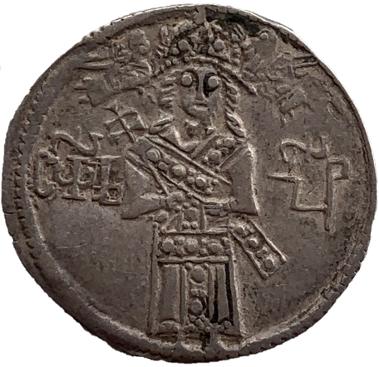
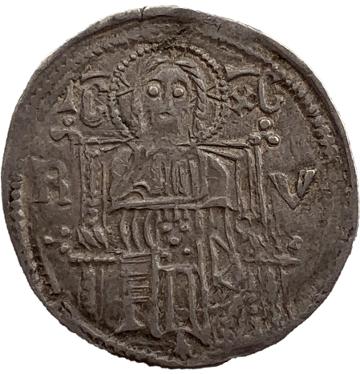
You can see whole collection in the pdf file below:

|
Serbian Medieval Coins Catalogue Zeljko Knezevic.pdf Size : 26214.133 Kb Type : pdf |
Serbia has a very rich coin minting history.
On the page “Serbian Cultural Heritage” there are Roman coins minted 3rd-4th century on the territory of todays Serbia, in Viminacium (today Kostolac), Dacia (today part of Banat) and Sirmium (today Sremska Mitrovica).
Serbian history, from the 7th to the 21st century, can be organised into 5 distinctive periods of time:
- Pre Nemanjic period 610-1166 (556 years)
- Nemanjic period 1166-1371 (205 years)
- Post Nemanjic period 1371-1463 (92 years)
- Ottoman occupation period 1463-1804 (341 year)
- Modern Serbian period 1804-present (219 years)
On this website first period, Pre Nemanjic period 610-1166, is covered on the web page called "Serbia 620-1166". Second and third period, Nemanjic period 1166-1371 and Post Nemanjic period is covered with individual ruler web pages. And last fifth period, Modern Serbian period 1804-present, is covered on the web page called "Serbia 1868-1945".
Serbian coinage can be divided into medieval and modern. Medieval lasted 350 years, from 1102 to 1463. Modern, as of year 2023, lasted 155 years from 1868 to 2023. Total minting history is therefore more then 500 years!
Serbian medieval coinage, from the 2nd and 3rd Serbian period, can be organized into 4 categories.
Kingdom, Empire, Despotate and Nobleman category.
While there are more, our collection consist of 10 kings, of which 2 ruled as emperors, 4 despots, 5 noblemen, 1 duke, 1 queen, 1 regent, 6 rulers of medieval Bosnia and 6 medieval city issues. Total 28 rulers!
1. First, there were Serbian Kingdom issues 1217-1346. Starting with the first (1) Serbian king Stefan The First-Crowned crowned in 1217 and ruled 1217-1228, succeeded by (2) Stefan Radoslav 1228-1234 and Stefan Vladislav I 1234-1243, (3) Uros The First or Uros The Great 1243-1276, (4) Stefan Dragutin 1276-1282, (5) Stefan Uros The Second Milutin 1282-1321, (6) Stefan Vladislav II 1321-1324 and (7) Stefan Uros The Third Decanski 1321-1331) until (8) king Stefan Dusan 1331-1346 was crowned as emperor 16th April 1346. There were 13 kings including Dusan and his son (9) Stefan Uros who was co-ruler as king Stefan Uros The Fourth with his father and then emperor Uros after his fathers death. Last 3 kings were (10) Vukasin Mrnjavcevic 1365-1371 who was co-ruler with Stefan Uros and his son Marko Mrnjavcevic known as Marko Kraljevic 1371-1395 who inherited royal title after his fathers death but had no real power. And finally king Stefan Tvrtko I Kotromanic 1377-1391.
2. Second, there were Serbian Empire issues 1346-1371. Starting with the elevation of the state from the kingdom to the empire when (1) king Stefan Dusan was crowned as emperor 16th April 1346 until his death in 1355 and his son (2) emperor Stefan Uros 1355-1371 who died childless. There were only 2 emperors.
3. Thirdly, there were Serbian Despotate issues 1402-1459. Starting with (1) despot Stefan Lazarevic who received despot title from Byzantine empire 1402-1427 succeeded by (2) Djuradj Brankovic 1427-1456, his 2 sons (3) Lazar Brankovic 1456-1458 and Stefan Brankovic 1458-1459 to despot Stefan Tomasevic who only ruled for few month before the fall of Despotate in 1459. And (4) despot Ugljesa Mrnjavcevic who ruled Ser 1365-1371. There were only 6 despots but 4 minted coins. Under Serbian Despotate 4 towns minted coins: Novo Brdo, Rudiste, Smederevo and Rudnik.
4. And fourthly, there were Nobleman issues ruling at various times and over various lands. (1) Lazar Hrebeljanovic 1371-1389 father of the first despot Stefan Lazarevic, (2) Vuk Brankovic 1371-1397 father of the second despot Djuradj Brankovic. Balsic noble family rulers of Zeta 1356-1421. (3) Djuradj II Stracimirovic Balsic 1385-1403 and (4) Balsa III Balsic 1403-1421. (5) Lazar Brankovic Lord of Kosovo 1406-1410 and (6) Vojvoda (duke) Ivanis (circa 1450-1459).
In addition while queens and empresses had appeared on coins we only have Queen Jelena Mrnjavcevic 1365-1388 independent issue and one regent princess Milica Hrebeljanovic 1389-1393.
Medieval Bosnia coinage can be categorized into 2 types of issues, ban and king issues. We have 2 ban rulers who minted coins, ban Paul and Mladen Subic 1299-1322 and ban Stefan II Kotromanic 1322-1353. 4 kings are (1) Stefan Tvrtko I Kotromanic 1377-1391, (2) Stefan Tvrtko II Kotromanic 1404-1409 and 1421-1443, (3) Stefan Tomas Ostojic 1443-1461 and (4) Stefan Tomasevic 1461-1463.
And finally we have 6 coast town issues under Nemanjic and Balsic rule which consists of Kotor, Ulcinj, Bar, Skadar, Svac and Drivast medieval towns.
In addition there are also Zvecan, Prizren and Skoplje issues.
We do buy individual coins and small or large collections so please contact us if you have any Serbian medieval coins for sale.
Please use references page for any coin identification and comparison purposes. Estimated value of the coins on this website have been based on Jovanovic catalog 2012 and various up to date world auctions. Where we couldn't find information or if coin doesn't appear in the catalog, we have estimated the value. If we decide to sell any of the coins here, our asking price may not necessary reflect catalog value or auction estimated or reached prices.
All these coins are part of our collection and displayed for comparison and research purposes only. If you want to use site as a price guide please follow ruler links above.
Research page has some files, books, study works and research free to download.
Following research shows all 113 known King Stefan Radoslav coins from the first two published by Dr Karl Stockert in Vienna in 1914, those published in books by Rastislav Maric 1956, Miroslav Jovanovic 2002 and 2012, Sergije Dimitrijevic 1997 and 2001 and Vujadin Ivanisevic 2001, study works by Museums in Belgrade, Nis, Sabac and Krusevac to the latest ones sold online and from private collections between 2012 and 2021. So over 105 years of publishing history. They are extremely rare as this Serbian king only ruled for 6 years in the first part of the 13th century.
Among the only known 113 King Stefan Radoslav coins we can differentiate 6 types:
- 93 “double cross with Constantine” type where all coins seem to be made of copper using at least 3 different dies.
- 7 “Mary mother of Jesus blessing the king” type with no high throne in the background.
- 1 “Mary mother of Jesus blessing the king” type with reverse just like type 2 with the same attire but obverse has the high throne in the background like type 1.
- 1 “Mary mother of Jesus blessing the king” type but unlike type 2 king wears different attire and its only coin where king holds its own scepter, a ceremonial staff or small banner.
- 9 “Jesus blessing the king” type made of copper.
- and only 2 “Jesus blessing the king” type like type 5 but coins are made of silver.
We can identify 2 different royal attires. First one is more common and found on most of copper and both known silver coins. King and Constantine wear a 5 dot belt and a long robe with a single dotted line in the middle. Second one is much more rare attire and its only found on type 2 where on coins number 8, 16, 27, 30, 34, 46 and 52 king has a 6 dot belt and a long robe with a twin parallel dotted lines in the middle.
All coins are found either in Novi Pazar, Stari Raš area, cut fragment no45 in Pomorie a town and seaside resort in southeastern Bulgaria, situated in Burgas Province, 20 km away from the city of Burgas in 2009 and around Skadar Lake area most recently.

|
Medieval Serbian Coins 6 Types Of King Stefan Radoslav v14.pdf Size : 4264.139 Kb Type : pdf |

|
Srednjovekovni Srpski Novac 6 Vrsta Kralja Stefana Radoslava v14.pdf Size : 4333.231 Kb Type : pdf |
What does analysis of these coins show?
Type 1. In his short history King Stefan Radoslav issued 93 so far known copper “double cross with Constantine” type coins with Greek legend CTEФANOC PIZ on the left, Greek letter Theta Θ and KONCTANTH on the right side on the obverse. King is wearing a 5 dot belt and a long robe with a single dotted line in the middle and Constantine is also wearing a 5 dot belt and a long robe but with a twin parallel dotted lines in the middle. Jesus seating on the high throne with Latin legend IC XC above on the reverse. All coins vary from 29mm to 32mm with 2 main differences, 1st: king and saint image is 18mm long and double cross is 20mm long from the top to the base with varied weight between 2g and 3g and 2nd: king and saint image is smaller, 17mm long and double cross is shorter, 18mm long from the top to the base but coins are heavier with varied weight between 3g and 4g. (Coin number: 1-7, 15, 17-26, 29-32, 35, 36, 43-45, 47-51, 53-113).
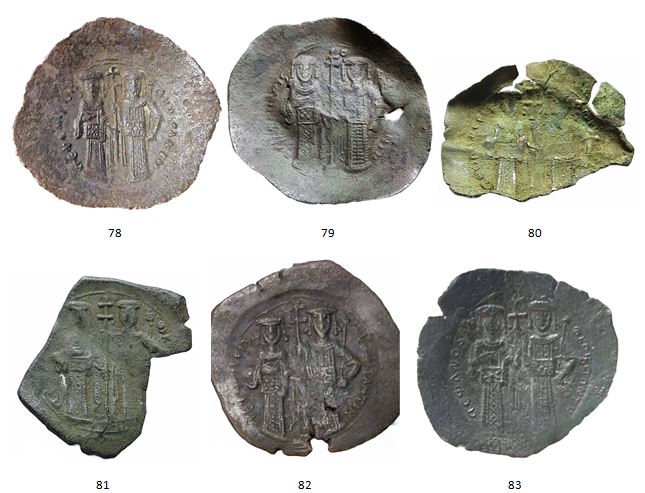
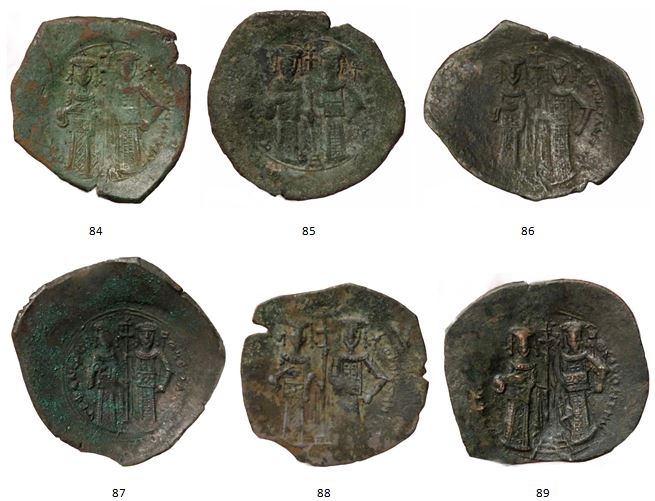
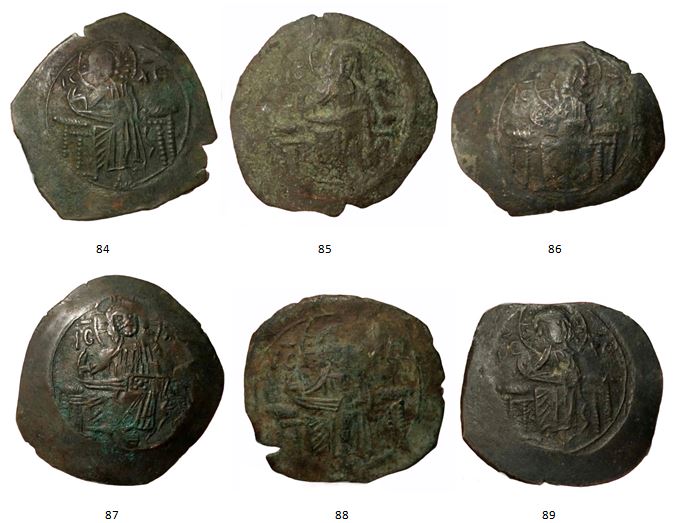
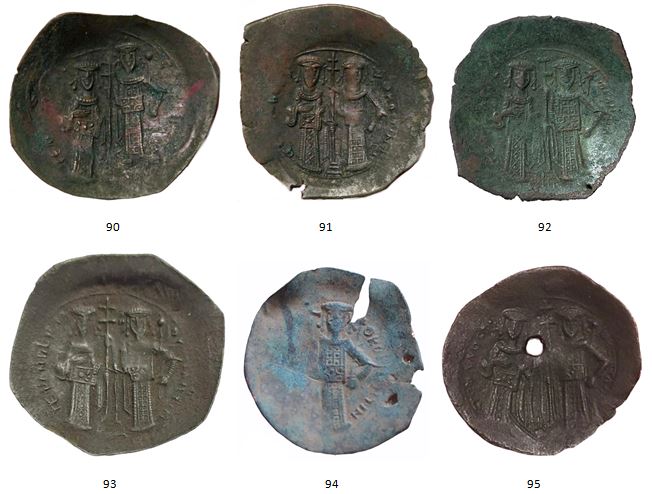
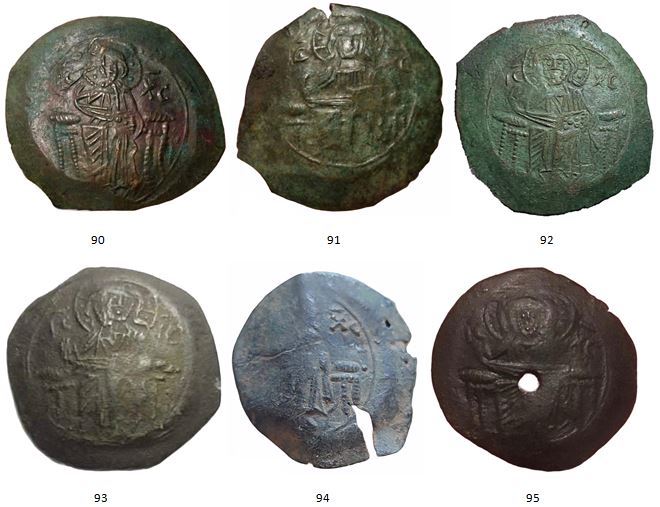
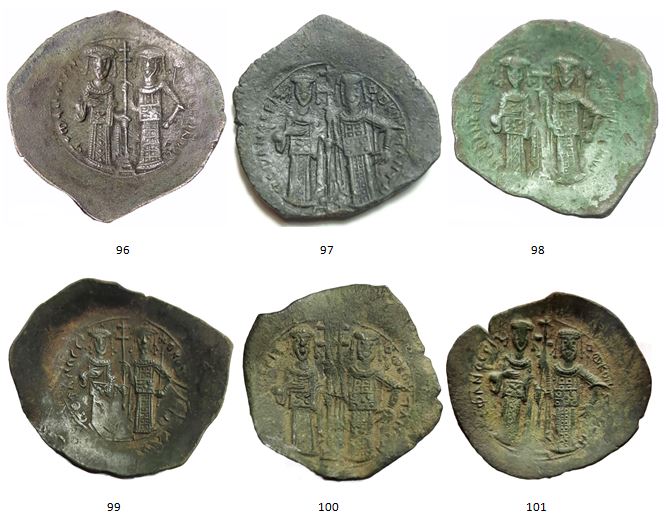
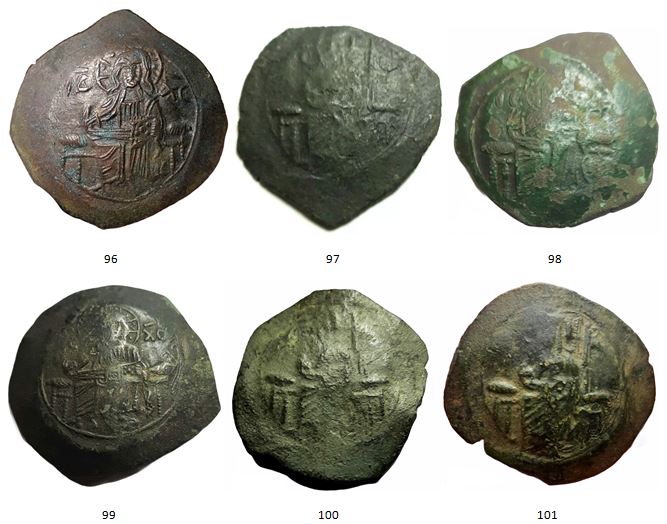
Type 2. 7 copper “Mary mother of Jesus blessing the king” type coins with Greek legend CTEФANOC PIZ on the left side, Greek initials MP (mother) in the middle and ΘV (of god) on the right side on the obverse. King is holding a globe wearing a 6 dot belt and a long robe with a single dotted line in the middle and Mary is wearing a long robe. Jesus enlarged sitting with Latin legend IC XC above but no visible throne in the background on the reverse. (Coin number: 8, 16, 27, 30, 34, 46 and 52).
Type 3. As a only exception here, and this is up to now, only known copper “Mary mother of Jesus blessing the king” type coin like type 2 where obverse has Greek legend CTEФANOC PIZ on the left side, Greek initials MP (mother) in the middle and ΘV (of god) on the right side but king is wearing a 5 (not 6) dot belt and a long robe with a single dotted line in the middle with Mary wearing a long robe. This is also only known coin where king is holding a globe and a scepter or a ceremonial staff on his own. Reverse is like “double cross” type 1 coins with Jesus, smaller in size, seating on the high throne in the background and Latin legend IC XC above. There is not a single known coin where king is holding globe and a scepter and with Jesus on the high throne which up to now was exclusively found on “double cross with Constantine” type 1 coins. This is unpublished and only known variant of all known King Stefan Radoslav coins. (Coin number: 33).
Type 4. This copper type is just like type 3 with “Mary mother of Jesus blessing the king” type coins with Greek legend CTEФANOC PIZ on the left side, Greek initials MP (mother) in the middle and ΘV (of god) on the right side on the obverse. Jesus enlarged sitting with Latin legend IC XC above but no visible throne in the background on the reverse just like type 2. The only difference is that king is holding globe but wears a different attire. King is wearing a 5 (not 6 – type 2) dot belt and a long robe with a single dotted line in the middle with Mary wearing a long robe. Like type 3 this is also only known example of its kind. (Coin number 9).
Type 5. 9 “Jesus blessing the king” type copper coins where number 11 has Greek legend CTEФANOC PIZ, Greek letter Theta Θ and ДUKAC signature on the left, IC in the middle and XC and OПANTOKPATOP on the right with the exception of the coin number 10 and 14, having ДUKA signature without C and all have isolated P on the obverse. King is holding a globe and wearing a 5 dot belt and a long robe with a single dotted line in the middle and Jesus is wearing just a long robe. Winged Archangel Michael holding sword and scrolls with Greek initials: ΜΗ(ΧΑΗΛ) ΑΡ(ΧΑΓΕΛΟΣ) to the sides standing for "Michael Archangel" which is Jesus name and the title in his pre-human existence, on the reverse. (Coin number: 10, 11, 14, 28 and 37-41).
Type 6. Finally 2 “Jesus blessing the king” type silver coins with Greek legend CTEФANOC PIZ, Greek letter Theta Θ and ДUKAC signature on the left, IC in the middle and XC and OПANTOKPATOP on the right. King is holding globe and wearing a 5 dot belt and a long robe with a single dotted line in the middle and Jesus is holding book of gospels and wearing just a long robe on the obverse. Winged Archangel Michael holding sword and scrolls with Greek initials: ΜΗ(ΧΑΗΛ) ΑΡ(ΧΑΓΕΛΟΣ) to the sides standing for "Michael Archangel" which is Jesus name and the title in his pre-human existence on the reverse. With coin number 11 these are only known silver coins in existence bearing in mind that coin number 13 is possibly a silver replica. (Coin number: 12 and 13).
It is also interesting to note similarities between copper coin number 11, 37 and 38 and silver coins number 12 and 13. All 5 have Greek legend CTEФANOC PIZ Θ ДUKAC signature on the left, IC in the middle and XC OПANTOKPATOP on the right on the obverse. King is holding a globe and wearing a 5 dot belt and a long robe with a single dotted line in the middle and Jesus is holding book of gospels and wearing just a long robe. Winged Archangel Michael holding sword and scrolls with Greek initials: ΜΗ(ΧΑΗΛ) ΑΡ(ΧΑΓΕΛΟΣ) to the sides standing for "Michael Archangel" on the reverse. These are only 5 examples in existence with preserved obverse featuring winged Archangel.
King Stefan Radoslav (1228-1233) choice was to model his coins according to Byzantine coins as his was under a strong Greek influence. His maternal grandparents were the Byzantine Emperor Alexios III Angelos (1195–1203) and Euphrosyne Doukaina Kamaterina, his father in law was Byzantine Emperor Theodore Komnenos Doukas (1215–1230) and his uncle was Byzantine Emperor Manuel Komnenos Doukas (1230-1237). Sadly it looks like it was these connections and his adherence to Greek culture that has cost him the throne only 5 years later at 1233 at the young age of 41.
- Coin no1 is kept in The Archaeological Museum in Split and is a first published King Radoslav coin by Dr Karl Stockert in Vienna in 1914, its 31mm, 3.29g. Same coin 2nd picture appears in Miroslav Jovanovic book Serbien Medieval Coins published in Belgrade in 2002 as a 4th coin listed on page 13 but claims that coin is 30mm and 3.26g. In his other book “Srpski Srednjovekovni Novac” 2012 is listed as a 4th coin on page 8 and in the book by Sergije Dimitrijević “Katalog Srpskog Srednjovekovnog Novca” 2001 under type 1 page 1.
- Coin no2 is coin published by Rastislav Maric in the book "Studies of Serbian Numismatics" in Belgrade in 1956. Mentioned by Dr Karl Stockert in Vienna in 1914 as being 29mm and 4.7g.
- Coin no3 was seen on Numizmatik Lanz auction July 1st 2011 and was featured in their catalog number 152 Lot 201. It was priced at 2000 euros but remained unsold. Then was consequently sold on eBay for around £650. Currently is in private hands and available for sale for 1100 euros.
- Coin no4 was published by Vujadin Ivanisevic in his book "Money of the Medieval Serbia" in Belgrade in 2001 listed in the book as 4th King Radoslav coin. Found in the area of the Fortress of Ras.
- Coin no5 was found during the archaeological excavations in Ras in 1974-75. Published by Sergije Dimitrijevic in his book "Medieval Serbian Coins" in Belgrade in 1997 page 19 and by Vujadin Ivanisevic in his study work called "Novac Kralja Radoslava King Radoslavs Coinage" 1998.
- Coin no6 was sold on cngcoins.com auction website for $2700 plus buyers auction fee which is normally 20%, its 32mm, 3g. It came back on sale November 2018 with auction ending January 2019 on the same website. It has sold again at CNG Jan 8th 2019 for $3250 plus 20% auction fee which is $650 ending with a $3900 price tag. Auction TRITON XXII Lot 1340.
- Coin no7 was sold on www.rudnik.com website for $1125, its 2.93g.
- Coin no8 was found during the archaeological excavations in Ras in 1976 and published by both Vujadin Ivanisevic in his book "Money of the Medieval Serbia", Belgrade, 2001 listed in the book as 3rd King Radoslav coin and Sergije Dimitrijevic in his book "Medieval Serbian Coins", Belgrade, 1997 page 18. Found in the area of the Fortress of Ras.
- Coin no9 is from a private collection of Lj. Nedeljković in his work page 31-39 and was published by Miroslav Jovanovic in his book "Serbien Medieval Coins" published in Belgrade in 2002 as 3rd coin listed on the page 13 and by "Catalogue of the Byzantine coins in the Dumbarton Oaks" Volume 4 Part 2 Plate XLVII.
- Coin no10 was published by Vujadin Ivanisevic in his book "Money of the Medieval Serbia", Belgrade, 2001 listed in the book as 2nd King Radoslav coin. Also identified by Marko Popovic in the publication "The Fortress of Ras" 1999. Found in the area of the Fortress of Ras
- Coin no11 is kept in National Museum of Serbia Belgrade. Its electrum meaning that it is made of a gold and silver mixture. Published by Rastislav Maric in the book "Studies of Serbian Numismatics" in Belgrade in 1956. This is a coin used on mobile phone card Telekom Serbia. 28mm, 2.67g.
- Coin no12 is kept in National Museum of Serbia Belgrade. Published by both Miroslav Jovanovic books "Serbien Medieval Coins" published in Belgrade in 2002 as 1st coin listed on page 12 and and “Srpski Srednjovekovni Novac” 2012 also as a 1st coin on page 6, in the book by Sergije Dimitrijević “Katalog Srpskog Srednjovekovnog Novca” 2001 under type 3 page 2 and by Vujadin Ivanisevic in his book "Money of the Medieval Serbia", Belgrade, 2001 listed in the book as 1st King Radoslav coin as well as on National Serbian Museum website in Belgrade www.narodnimuzej.rs. 29mm, 2.55g.
- Coin no13 was sold on www.limundo.com auction website in 2015, 25mm, 4.7g. Its currently owned by us, reference number #SR01 and its available to view at King Stefan Radoslav page. Possibly made by Peoples Museum Belgrade as a silver counter stamped replica.
- Coin no14 was published by Miroslav Jovanovic in his books "Serbien Medieval Coins" published in Belgrade in 2002 as 2nd coin listed on the page 12 and “Srpski Srednjovekovni Novac” 2012 as a 2nd coin on page 7and it’s on www.muzejras.org website without obverse. 31mm, 4.02g
- Coin no15 was sold on Numismatik and Naumann auction website May 7th 2017 for 2400 euros. 29mm, 3.22g. Auction 53 Lot 971.
- Coin no16 was found in Raska area and sold in Vienna in 1996 for 10000 schillings which at the time of introduction to euro currency was around 725 euros. Second picture is original condition that coin was found in.
- Coin no17 was sold on Stacks and Bowers auction website Jan 12th 2009 for $2875 plus auction fees. 3.88g, 31mm.
- Coin no18 was sold to private collection, 2.73g, 29mm.
- Coin no19 was sold to private collection, 2.62g, 30mm.
- Coin no20 was bought for 1100 euros from private collection in 2018.
- Coin no21 is sold to a private collector.
- Coin no22 was sold to private collection in 2018.
- Coin no23 was sold to private collection in 2018.
- Coin no24 is part of our collection. Reference number #SR03 and its available to view at King Stefan Radoslav page.
- Coin no25 was also sold to private collection.
- Coin no26 was also sold to private collection Jan 2019 for 1400 euros.
- Coin no27 was identified by Vujadin Ivanisevic in the publication "The Collection of Works by Byzantine Institute" 1998.
- Coin no28 was also identified by Marko Popovic in the publication "The Fortress of Ras" 1999. Found in the area of the Fortress of Ras.
- Coin no29 was also sold to private collection.
- Coin no30 is kept in The State Hermitage Museum of art and culture in Saint Petersburg, Russia number 151. Published by Sergije Dimitrijevic in his book "Katalog of the Serbian Medieval Coins" 2001 page 1 listed in the book as 2nd coin and by "Catalogue of the Byzantine coins in the Dumbarton Oaks" Volume 4 Part 2 Plate XLVII.
- Coin no31 was found during the archaeological excavations in Ras in 1974-75. Published by Ph. Grierson from his collection number 6, by M. Handy in "Coinage and Money in the Byzantine Empire 1081-1261", D. O. "Center for Byzantine Studies" 1961 page 297-298 T. 47 1, in Numizmatičar number 8 issued in 1985 by Serbian Numismatic Society as a type III coin number 6 and in Numizmatički Časopis Dinar Broj 1 1996 page 8.
- Coin no32 is published by The Barber Institute of Fine Arts Birmingham in Coins Catalog 2007 page 36 and also mentioned in Numizmatički Časopis Dinar Broj 28 2007 page 22.
- Coin no33 is the only known copper “Mary blessing the king” type coin with the high throne currently owned by us, reference number #SR04 and its available to view at King Stefan Radoslav page.
- Coin no34 was published by Miroslav Jovanovic in his book "Serbian Medieval Coins" published in Belgrade in 2012 as 3rd coin listed on the page 7.
- Coin no35 was seen on eBay in 2019/2020 for $150 coming from a private collection. It is possible that coins 20-26, 29 and this one number 35 are coming from so called Skadar lot found around Skadar Lake area.
- Coin no36 is kept in Fitzwilliam Museum Cambridge England and its being published in "Catalogue of the Byzantine coins in the Dumbarton Oaks" Volume 4 Part 2 Plate XLVII.
- Coins no37 is kept in The State Hermitage Museum of art and culture in Saint Petersburg, Russia, the second-largest art museum in the world, number 150 published in Numizmatičar number 8 issued in 1985 by Serbian Numismatic Society as a type Ia coin number 3.
- Coin no38 is from a private collection of Lj. Nedeljković in his work page 31-39 and published in Numizmatičar number 8 issued in 1985 by Serbian Numismatic Society as a type Ib coin number 1.
- Coin no39 was found during the archaeological excavations in Ras in 1976 and published in Numizmatičar number 8 issued in 1985 by Serbian Numismatic Society as a type Ic coin number 3.
- Coin no40 was found during the archaeological excavations in Ras in 1976 and published in Numizmatičar number 8 issued in 1985 by Serbian Numismatic Society as a type Ic coin number 4.
- Coin no41 was found during the archaeological excavations in Ras in 1976 and published in Numizmatičar number 8 issued in 1985 by Serbian Numismatic Society as a type Ic coin number 5.
- Coin no42 is kept in The Archaeological Museum in Zagreb number 1061 and published in Numizmatičar number 8 issued in 1985 by Serbian Numismatic Society as a type III coin number 3.
- Coin no43 is kept in The Kunsthistorisches Museum of art in Vienna, Austria and published in Numizmatičar number 8 issued in 1985 by Serbian Numismatic Society as a type III coin number 2.
- Coin no44 was found during the archaeological excavations in Ras in 1974-75 and published in Numizmatičar number 8 issued in 1985 by Serbian Numismatic Society as a type III coin number 5.
- Coin no45 cut fragment was found in Bulgarian town Pomorie in 2009 with only "OC PIZ" legend visible on the reverse and published in Numismatics, Sphragistics & Epigraphy 2015 No 11 by Vladimir Pencev Pages 69-71, Plate IX No 1.
- Coin no46 was sold on cngcoins.com auction website July 2019 for $2000 plus 18% buyer fee totaling $2360, described as being 2.70g.
- Coin no47 was sold from a private collection, it is currently owned by us, reference number #SR05 and its available to view at King Stefan Radoslav page.
- Coin no48 was seen on eBay in 2019/2020 for $150 coming from a private collection.
- Coin no49 was sold from a private collection, it is currently owned by us, reference number #SR06 and its available to view at King Stefan Radoslav page.
- Coin no50 is in a private collection. Valued by the owner at 500 euros.
- Coin no51 is also in a private collection. In addition to the above coins 20-26, 29 and 35 it is possible that these last 5 coins 47-51 are also coming from so called Skadar lot found around Skadar Lake area.
- Coin no52 was found in Novi Pazar area, sold for 1000 euros and is in a private collection.
- Coin no53 is in a private collection. Valued by the owner at 300 euros.
- Coin no54 is in a private collection. Valued by the owner at 500 euros.
- Coin no55 is in a private collection. Valued by the owner at 250 euros.
- Coin no56 is in a private collection. Valued by the owner at 1350 euros.
- Coin no57 was sold on leunumismatik.com online auction website lot number 2583 February 22nd 2020 for 550 CHF plus 18.5% auction fee around 615 euros. Auction Webauktion 11 Lot 2583.
- Coin no58 is in a private collection.
- Coin no59 is in a private collection. These last 2 coins are owned by the same owner a valued at 800 and 500 euros. Hole in the middle is usually done to cancel currency and take it out of circulation.
- Coin no60 coming from a private collection.
- Coin no61 was seen on eBay in March 2020 for $800 coming from a private collection.
- Coin no62 was seen on eBay in 2020 coming from a private collection.
- Coin no63 coming from a private collection.
- Coin no64 was seen on eBay in 2020 coming from a private collection.
- Coin no65 is in a private collection.
- Coin no66 is in a private collection.
- Coin no67 is in a private collection.
- Coin no68 is in a private collection.
- Coin no69 is in a private collection.
- Coin no70 has a strange faces and separated letters C and T as well as unusual second letter C joined with title PIZ therefore making us conclude that this coin is a forgery or counterfeited medieval or possibly modern fake.
- Coin no71 is in a private collection.
- Coin no72 is in a private collection and was available to buy for 450 euros.
- Coin no73 was sold on Leu Zurich auction house May 10th 2006 for 4000CHF. Auction 97 Lot 211.
- Coin no74 was bought from a private collection for 550 euros.
- Coin no75 is in a private collection.
- Coin no76 is in a private collection, holed.
- Coin no77 is in a private collection, holed.
- Coin no78 is in a private collection.
- Coin no79 is in a private collection.
- Coin no80 is in a private collection, seen on eBay.
- Coin no81 is in a private collection, seen on eBay.
- Coin no82 is in a private collection.
- Coin no83 is in a private collection, sold for 1200 euros but sadly looks like its fake.
- Coin no84 1 of 9 found in small hoard. This one and next 8 coins were found together and sold to collectors.
- Coin no85 2 of 9 found in small hoard.
- Coin no86 3 of 9 found in small hoard.
- Coin no87 4 of 9 found in small hoard.
- Coin no88 5 of 9 found in small hoard.
- Coin no89 6 of 9 found in small hoard.
- Coin no90 7 of 9 found in small hoard.
- Coin no91 8 of 9 found in small hoard.
- Coin no92 9 of 9 found in small hoard. Now owned by us. Reference number #SR07 and its available to view at King Stefan Radoslav page.
- Coin no93 is in a private collection, seen on eBay.
- Coin no94 is in a private collection, seen on eBay.
- Coin no95 is in a private collection. Holed
- Coin no96 is part of our collection. Reference number #SR08 and its available to view at King Stefan Radoslav page.
- Coin no97 is in a private collection.
- Coin no98 is in a private collection.
- Coin no99 is in a private collection, seen on eBay.
- Coin no100 is in a private collection.
- Coin no101 is in a private collection.
- Coin no102 is in a private collection.
- Coin no103 is in a private collection.
- Coin no104 is in a private collection.
- Coin no105 is in a private collection.
- Coin no106 is in a private collection.
- Coin no107 is in a private collection.
- Coin no108 is in a private collection.
- Coin no109 is in a private collection.
- Coin no110 is in a private collection.
- Coin no111 is in a private collection. It doesn't look right it appears to be acounterfeit.
- Coin no112 is in a private collection.
- Coin no113 is in a private collection.
Numizmatičar number 8 issued in 1985 by Serbian Numismatic Society has an article by Dobrila Gaj-Popović "Novac i Kovnica Kralja Radoslava" that has listed 31 King Stefan Radoslav coin as found in Novi Pazar and Stari Raš area. 10 of those coins listed (coins no 1, 5, 8, 10, 11, 12, 14, 28, 30 and 31) we have already identified and are listed above as there were published in various books and study works over the years. 12 are found in really bad, thin or broken condition and are pictured in reverse only. 9 are added to the list and numbered 37 - 44. Out of all 31 found 22 are copper “Jesus blessing the king” type 5 but as we have stated sadly 12 of those, as shown below, are in a really poor condition. 3 are “Mary mother of Jesus blessing the king” type 2 and 6 “double cross with Constantine” type 1.
Translate This Page
Copyright © 2020